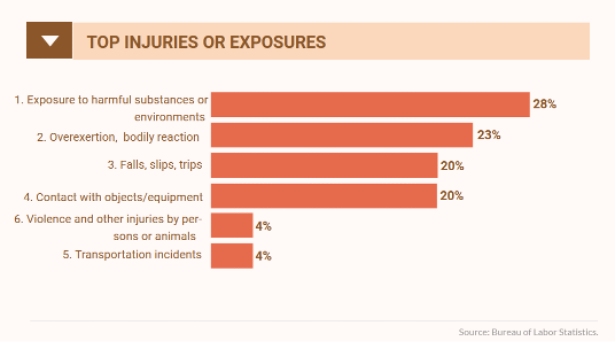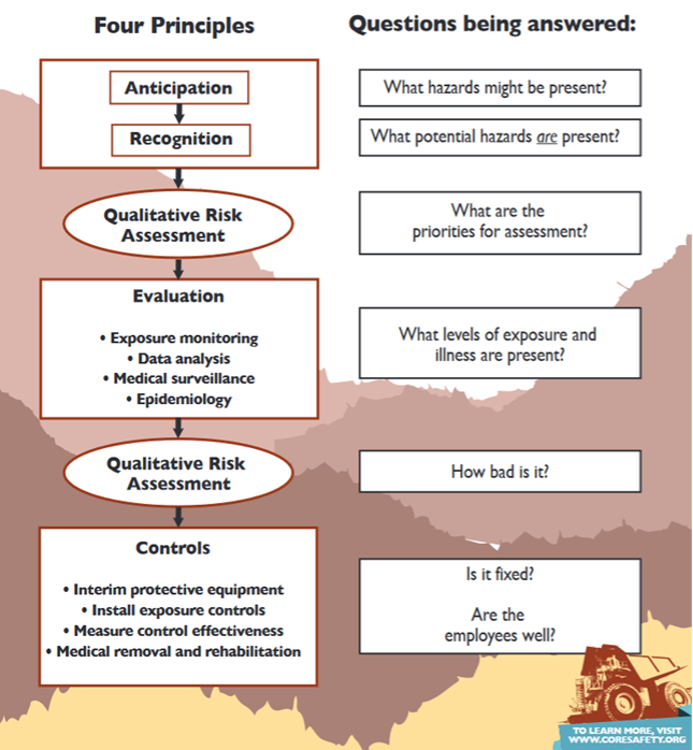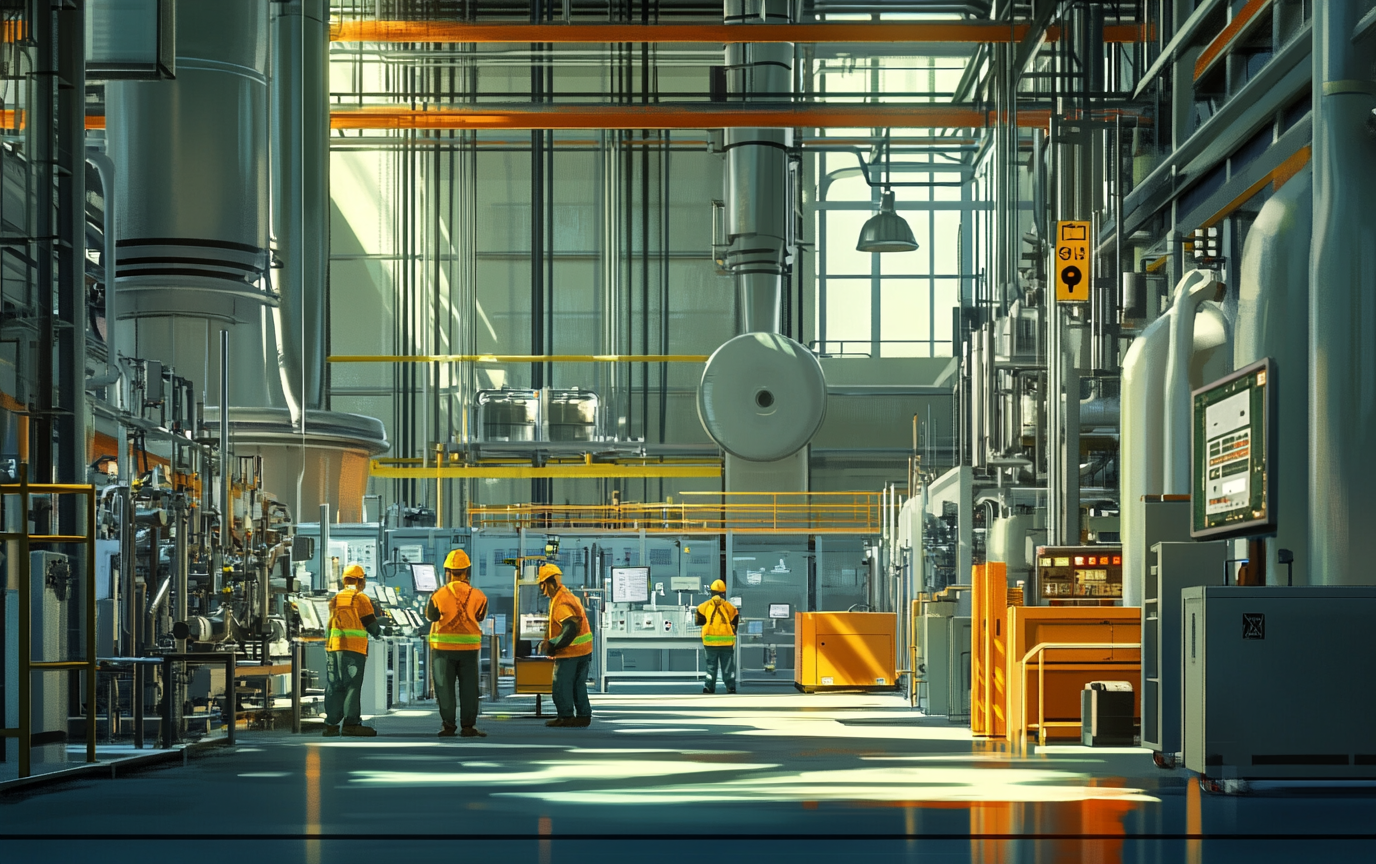- Industrial hygiene and safety practices are essential to make workplaces in manufacturing industries safe and healthy for the workers.
- Employers implementing effective industrial hygiene and safety have several benefits, such as lowering worker illness and injuries and reducing facility damages.
- Other benefits include improved worker morale, productivity, lower costs, and compliance with regulations.
- Several national-level agencies have standards and regulations to enforce and guide industrial hygiene and safety.
Industrial hygiene and safety are essential to maintain a healthy and safe work environment in manufacturing facilities. Industries must detect and handle chemical, environmental, biological, physical, and ergonomic hazards not only for regulation compliance but also to protect their workers, the neighboring community, and their facilities. In this article, find out more about industrial hygiene and safety and its importance.
What is Industrial Hygiene and Safety?
Industrial hygiene and safety is a multidisciplinary scientific approach to ensure the safety and health of workers in manufacturing workplaces.
Occupational Safety and Health Administration (OSHA) regulations in the USA require employers to ensure industrial hygiene and safety.
Hazards in industrial workplaces can lead to two types of harm- safety and health.
- Industrial hygiene: Industrial hygiene identifies and controls hazards that cause occupational exposures and ill health (illness, diseases, or fatalities). Industrial hygienists rely on monitoring the environment and analysis to detect workers’ exposure to risks and their extent and identify methods to eliminate, reduce, or control hazards.
- Industrial safety: Industrial safety focuses on eliminating unsafe work practices that cause accidents, injuries, fires, and explosions. Industrial safety measures include investigating incidents and enforcing corrective procedures for future prevention. Safety officers must develop and implement policies and protocols to enforce regulations and standards.
Hazards can cause one or both types of impacts, so the two functions can overlap. For example, hydrogen sulfide, a gas, can have serious health consequences and is also an explosive requiring emergency response. In such cases, industrial safety must also cover health risks that are usually considered an industrial hygiene aspect.
Hygiene and safety aspects are equally important, and the need will depend on the type of hazards involved in an industry.
Industrial Hygiene Hazards

Figure 1: The top causes of injuries and exposures in the USA workplace, NSC. (Image credits: https://injuryfacts.nsc.org/work/work-overview/top-work-related-injury-causes/)
Workers can be exposed to several hazards, which are classified into five types:
- Chemical hazards: These can be solids, liquids, gases, mists, fumes, and vapors that can be toxic, corrosive, or explosive.
- Biological hazards: Workers can be exposed to dangers like bodily fluids or microbes like viruses, bacteria, fungi, and other organisms that cause acute or chronic infections.
- Physical hazards: The causes of physical hazards include ionizing and nonionizing heat, noise, vibration, light, and electromagnetic radiation.
- Ergonomic hazards: Many tasks can cause ergonomic risks, including lifting and pushing heavy machinery. Repetitive movements and shocks or working at high speeds can be other causes.
- Air or environmental contaminants: This group covers pollutants that are particulate, gases, and vapor. Common air pollutants are dust, fumes, gases, fibers, and aerosols.
According to the U.S. Bureau of Labor Statistics (BLS), between 2021-2022, about 1,001,440 “Days Away from Work, Job Restriction, or Transfer” (DART) cases were reported. Of these, exposure to harmful substances or the environment was the number one cause and accounted for 28% of cases, followed by overexertion, falls, and slips (see Figure 1). These top three causes caused 75% of nonfatal injuries and illnesses.
Moreover, exposure to harmful chemicals and the environment led to a day’s absence from work in 96.3% of cases.
Industrial Hygiene Process

Figure 2: Industrial hygiene has four principles- to “anticipate, recognize, evaluate, and recommend controls,” Coresaftey.org. (Credits: https://www.coresafety.org/wp-content/uploads/2019/08/The_Four_Basic_Principles_of_Industrial_Hygiene_in_Mining.01.pdf)
Industrial hygienists must identify hazards and suggest means to eliminate or control causes. The specific measures to protect health and safety will depend on the type of hazards, the industry, and the workplace.
Industrial hygiene uses the principles of anticipation, recognition, evaluation, and control of the factors that cause health problems, as shown in Figure 2.
Anticipation: Industrial hygienists predict potential hazards that can be present in an industry and workplace before they occur.
Recognition: Hygienists determine actual existing hazards in the workplace.
Evaluation: The third step involves assessing the hazards’ severity, exposure magnitude, and their potential impacts.
Control: Industrial hygienists apply appropriate technology and protocols to eliminate or reduce exposure hazards to acceptable levels.
The four approaches can take place in two stages- workplace analysis and controlling risks.
Workplace analysis
Industrial hygienists conduct workplace analysis to determine all the jobs, operations, and workstations that can produce or involve hazards. To anticipate, recognize, and evaluate dangers, they can use the following resources:
- Inspect the workplace
- Collect and analyze data from the workplace
- Analyze toxicology reports
- Utilize applied scientific principles and research to identify how the existing hazards can impact workers’ health.
- If a hazardous situation is encountered, recommend appropriate corrective measures.
Controlling hazards
Industrial hygienists must develop remediation and control measures to eliminate or reduce occupational risks from hazards, using the hierarchy of controls approach. The order of preference is elimination, substitution, engineering controls, administrative controls, and personal protective equipment (PPE) use. Eliminating and substituting harmful substances or risks need to be taken during an industry’s planning and construction phase.
- Engineering controls: Several engineering solutions can be used to reduce personnel exposure to hazards, such as ventilation systems to reduce toxic gases and vapors, enclosing work processes, etc.
- Work practice controls: Industrial hygienists can change workplace practices to control hazards. These measures can include inspection and maintenance of processes and equipment, supervision, housekeeping procedures, prohibiting smoking, applying cosmetics, eating in areas of high risk, etc.
- Administrative controls: Employers can reduce exposure by scheduling high-risk operations and tasks when fewer employees are around.
- PPE: When controls are not enough to reduce exposure risks, it will be necessary for personnel to use appropriate PPE like gloves, safety goggles, helmets, clothing, and respirators while working and during emergency response. The PPE must also be checked, maintained, and replaced to ensure efficient protection.
To ensure that these procedures are effective, employers must communicate and train managers and workers on the hazards, their impacts, and measures to properly control them.
Benefits of Industrial Hygiene and Safety
Not implementing industrial hygiene and safety can have severe consequences. Businesses and manufacturers can expect several benefits when industrial hygienists and safety officers ensure health and safety in the workplace. These benefits are discussed below.
- Prevents or reduces workplace illnesses and injuries: An efficient industrial hygiene and safety program will prevent or lessen the disease and injuries that workers suffer, by identifying and controlling workers’ exposure to hazards. Several chemicals can cause severe acute and chronic respiratory and skin diseases and cancer if exposure levels are not within acceptable levels.
- Improves workers’ morale and loyalty: Workers will trust employers they know are taking measures to ensure their health and safety. It will help employers retain personnel.
- Increases productivity: When people are working in safe and comfortable environments, they are more productive. Workers will focus on their jobs without worrying about impacts on their health and safety. Also, lower incidents of illness and injuries mean less absenteeism.
- Reduces damage to facility: Good safety protocols can reduce accidents like leaks, fires, and explosions that can also damage the facility and have a severe environmental impact.
- Saves costs: Effective industrial hygiene and safety practices can cut several costs for employers.
- They will have lower healthcare costs due to illness and injuries.
- They pay less compensation costs.
- Lower worker turnover costs due to recruitment, training, and onboarding.
- Less or no damage to facilities can save on expenses and maintain productivity.
- Compliance with regulations: Industrialists who comply with occupational health and safety regulations, avoid fines, legal issues, and bad reputations.
- Brand building: Companies that ensure industrial hygiene and safety can build their reputation and brands among workers, investors, consumers, and the local community.
As a result of better productivity, fewer costs, and brand loyalty, businesses can expect better ROI by implementing effective industrial hygiene and safety.
Standards and Regulations
Ensuring industrial hygiene and safety is a continuous process. Regular review, checks, and maintenance are necessary to meet regulations and standards even after analysis and controls. National, state, and local governments can have standards and limits for exposure to hazards, which employers must always maintain. The following agencies set the primary standards employers must comply with:
OSHA: The agency has several regulations that must be followed, such as employer responsibilities, the OSHA Hazard Communication Standard, etc.
National Institute for Occupational Safety and Health: NIOSH conducts research and provides recommendations to reduce workplace hazards, but they are not legally enforceable.
American Conference of Governmental Industrial Hygienists: The ACGIH Threshold Limit Values (TLVs) for chemicals and gases proposed by this agency are recommendations but are not legally enforceable.
The Environmental Protection Agency: The EPA has many regulations to limit chemical use through the Toxic Substances Control Act (TSCA) and control pollution.
American National Standards Institute: ANSI standards control work practices to ensure equipment safety and reduce accidents, falls, etc.
National Fire Protection Association: NFPA aims to prevent workplace fires and explosions. Its codes affect all buildings and processes.
Role of Gas Detection in Industrial Hygiene and Safety
Chemicals and air contaminants are prevalent hazards in many industries. Facilities can use or emit chemicals from machinery or processes harmful to workers’ health or pose fire or explosion risks. Gas detection is critical in ensuring safety and health by detecting potential leaks and high levels of hazardous gases. Interscan produces fixed and portable gas sensors for over 20 hazardous gases suitable for several industries.
Find out more about how Interscan can improve your manufacturing facilities’ industrial hygiene and safety.
Sources
NASP. (n.d.). The Critical Importance of Industrial Hygiene in the Workplace. Retrieved from https://www.naspweb.com/blog/the-critical-importance-of-industrial-hygiene-in-the-workplace/
OSHA. (n.d.). Industrial hygiene. Retrieved from https://www.osha.gov/sites/default/files/training-library_industrial_hygiene.pdf
Tulane University. (2021, Nov 10). What Is Industrial Hygiene? Retrieved from https://publichealth.tulane.edu/blog/what-is-industrial-hygiene/


